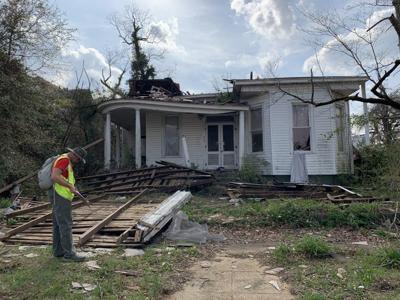Immediately after the Jan. 12 tornado tore through Selma, local historians hit the ground surveying damage to the city’s treasured historic properties that landed in its path.
Last week, local historians got help from national nonprofit historic preservation organization Atlantic Heritage that oversaw sending a group of design students from the University of Georgia to come to Selma and gather data that will assist with the Queen City’s rebuilding efforts.
Ed Barnes of Atlantic Heritage led the students from the College of Environment and Design through performing a tornado damage survey on 300 homes and properties in and around Selma’s four historic districts.
The information will be compiled with local data by Selma Dallas Historic Preservation Society Board Member Sarah Aghedo for a comprehensive list of needs that will be available for all to search but also to use in advocating preservation and restoration of the unique timeless structures, Barnes said.
“It’s a good practice to do a damage survey after an event like this,” he said.“Especially in nationally registered historic districts.”
The records will also help homeowners apply for insurance and federal assistance to cover costs of rebuilding the historic structures similar to how it was before the storm.
“We photographed the buildings from every angle,” Barnes said.“We then took down information about the physical condition we could observe. … It will provide a record of the elements of the building that were there at the time.”
The five students under the leadership of Professor of Landscape Architecture and Historic Preservation Cari Goetcheus spent two days of their spring break in Selma conducting the tornado damage surveys. They stayed with Chip Spencer of Spencer Farms in Old Marion Junction.
“The idea is to get a better understanding of the extent of damage and what it will take to restore the damaged historic structures,” Barnes said.“This is a win-win situation for everyone. The city gets the survey and the students get hands-on experience.”
Barnes said the surveywas carried out March 6 and 7 and focused on the path of the tornado, which was the northern most part of the Old Town Historic District and the Ice House Historic District. The students put in long hours and surveyed as many buildings as possible over the two days.
While surveying, students were able to gather stories from the homeowners that will be preserved. The students heard the stories of where the homeowners were and what they did when the storm hit, and they got personal stories and histories of the families who lived in the house that will be documented.
They also told stories of past changes to the actual structure and grounds that will help with reconstruction.Barnes said this did not happen at every home, but when it did, he encouraged the students to listen closely and take it down so these histories are now recorded. “The students felt his helped them to really learn about the city and the people and the places.”
Barnes stayed another week after the students left to conduct more surveys.He is unsure where this data will be housed just yet, but once he compiles all of it, there will be copies made and shared with several groups and places including with Linda Derry, President of the Historical Society.















(0) comments
Welcome to the discussion.
Log In
Keep it Clean. Please avoid obscene, vulgar, lewd, racist or sexually-oriented language.
PLEASE TURN OFF YOUR CAPS LOCK.
Don't Threaten. Threats of harming another person will not be tolerated.
Be Truthful. Don't knowingly lie about anyone or anything.
Be Nice. No racism, sexism or any sort of -ism that is degrading to another person.
Be Proactive. Use the 'Report' link on each comment to let us know of abusive posts.
Share with Us. We'd love to hear eyewitness accounts, the history behind an article.